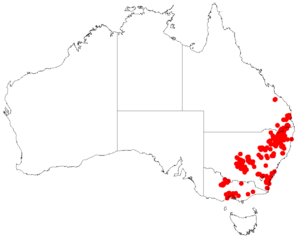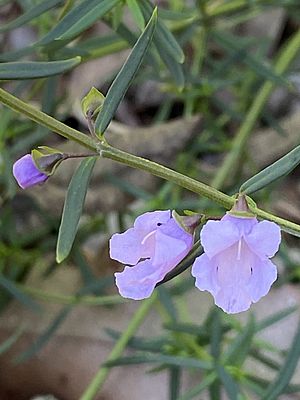Snowy mint-bush facts for kids
Quick facts for kids Snowy mint-bush |
|
|---|---|
 |
|
| Prostanthera nivea var. nivea in Girraween National Park | |
| Scientific classification | |
| Genus: |
Prostanthera
|
| Species: |
nivea
|
 |
|
| Occurrence data from AVH | |
The Prostanthera nivea, also known as the snowy mint-bush, is a type of flowering plant. It belongs to the Lamiaceae family, which includes mints. This plant is found only in eastern Australia. It is a shrub with long, thin leaves and white flowers. These flowers grow where the leaves meet the stems, usually near the ends of the branches. Unlike many other mint-bushes, the snowy mint-bush does not have a strong minty smell.
Contents
What Does the Snowy Mint-Bush Look Like?
The snowy mint-bush is a shrub that can grow upright or spread out. It usually reaches a height of 1 to 4 meters (about 3 to 13 feet). Its branches have four ridges, but the plant itself does not smell like mint.
Its leaves are long and narrow, like a line or a cylinder. They are about 10 to 50 millimeters (0.4 to 2 inches) long and 0.5 to 2 millimeters (0.02 to 0.08 inches) wide. The leaves are "sessile," meaning they attach directly to the stem without a small stalk.
The flowers grow in the "leaf axils," which are the spots where leaves join the stem. They are usually found near the tips of the branches. Small, hard-to-see leaf-like parts called "bracteoles" can be found at the base of the flowers, sometimes up to 4 millimeters long.
The green parts that protect the flower bud, called "sepals," are 6 to 8 millimeters long. They form a tube about 3 to 4 millimeters long. This tube has two parts, or "lobes," with the top one being 3 to 5 millimeters long. The petals are white, sometimes with a hint of purple. They are 14 to 18 millimeters long and have yellow spots inside the flower's tube. The snowy mint-bush blooms from September to December.
How the Snowy Mint-Bush Got Its Name
The way plants are named and grouped is called "taxonomy." The snowy mint-bush was first officially described in 1834 by a botanist named George Bentham. He used notes from another botanist, Alan Cunningham. Bentham published his description in his book, Labiatarum Genera et Species.
George Bentham also described two different types, or "varieties," of the snowy mint-bush. These varieties are still recognized today by the Australian Plant Census.
Varieties of Snowy Mint-Bush
- Prostanthera nivea var. induta: This variety is an upright shrub, often quite dense. It usually grows 1 to 2 meters (3 to 6.5 feet) tall. Its branches are covered with many white hairs. The leaves are mostly 1 to 2 millimeters wide. It has noticeable, linear bracteoles that are 2 to 4 millimeters long.
- Prostanthera nivea var. nivea: This variety is also an upright shrub, but it can be thinner. It grows 1 to 4 meters (3 to 13 feet) tall. Its branches are either smooth (without hairs) or have only a few white hairs. The leaves are usually thinner, about 0.5 to 1 millimeter wide. Its bracteoles are small and hard to see.
Where the Snowy Mint-Bush Lives
The snowy mint-bush is found in south-eastern Queensland, eastern New South Wales, and Victoria in Australia. It grows in different types of environments like forests, woodlands, and open heathlands.
The induta variety often grows in rocky cracks or on ledges in a place called the Warrumbungles. It has also been found once in the Pilliga forest.



